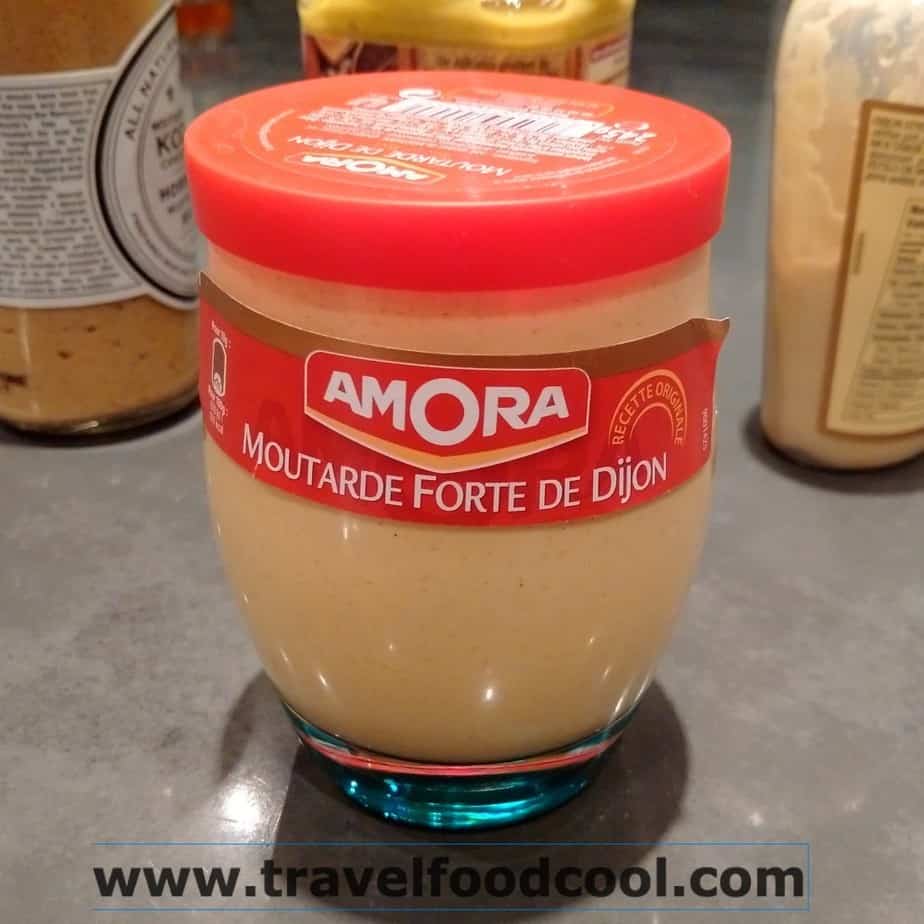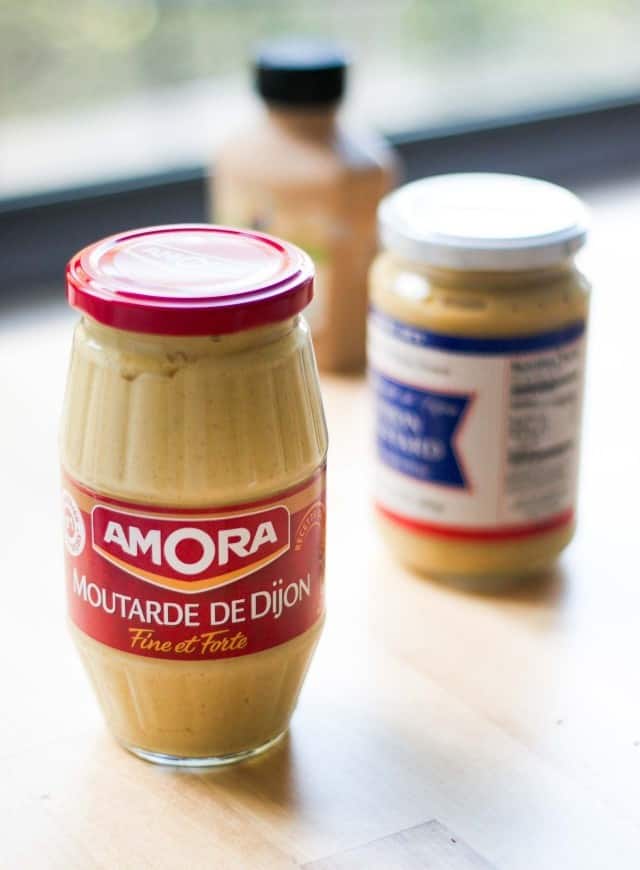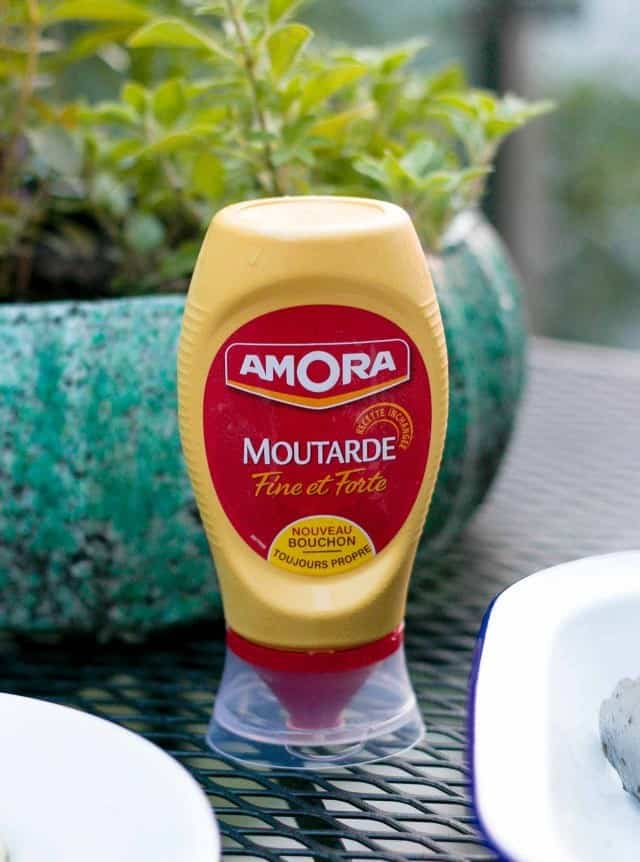
We are pleased to present the first installment of a new soon-to-be-extremely-popular feature on Travel*Food*Cool: The Mustard Report.
Mustard is a condiment made from the seeds of the mustard plant. Whether white or yellow, brown or black, mustard is one of the most popular and widely-used spices and condiments in the world. It is found in the cuisine of India and Bangladesh, the Mediterranean, northern and southeastern Europe, Asia, the Americas and Africa.
Today we set out on our journey to discover and fete the huge variety of mustards our world has to offer. We start with a classic Dijon mustard from France: Amora.

Here in North America, there is perhaps no easier way to demonstrate your refined palate to one and all than by choosing Dijon mustard over a standard yellow ballpark mustard. Remember the aristocratic gentleman being chauffeured in a Rolls Royce who pulls up alongside another Rolls Royce at a stop, rolls down the window and asks ‘Pardon me, would you have any Grey-Poupon?’

Dijon mustard was created when Jean Naigeon of Dijon substituted verjuice, the acidic “green” juice of unripe grapes, for vinegar in the traditional mustard recipe. Most mustards from Dijon today contain white wine rather than verjuice. Interestingly, “Dijon mustard” is not a protected food name. While mustard factories still operate in Dijon and adjoining towns, most mustard described as “Dijon” is manufactured elsewhere. Even that produced in France is made almost exclusively from Canadian (!) mustard seed.
According to Wikipedia, the Romans were the first to experiment with the preparation of mustard as a condiment. They mixed unfermented grape juice, known as “must”, with ground mustard seeds (called sinapis) to make “burning must”, mustum ardens — hence “must ard”. A recipe for mustard appears in Apicius, the anonymously compiled Roman cookbook from the late 4th or early 5th century, as a glaze for roasted boar.
The Romans likely exported mustard seed to Gaul and by the 10th century, monks of Saint-Germain-des-Prés in Paris absorbed the mustard-making knowledge of Romans and began their own production. The first appearance of mustard makers on the royal registers in Paris dates back to 1292. Dijon, France became a recognized center for mustard making by the 13th century. In 1777, one of the most famous Dijon mustard makers, Grey-Poupon, was established as a partnership between Maurice Grey, a mustard maker with a unique recipe containing white wine, and Auguste Poupon, his financial backer. Their success was aided by the introduction of the first automatic mustard-making machine. In 1937, Dijon mustard was granted an Appellation d’origine contrôlée. Due to its long tradition of mustard making, Dijon is regarded as the mustard capital of the world.
Although Grey-Poupon and Maille mustards are widely available in North America, Amora is not. Grey-Poupon is now, in fact, made by an American company (Kraft) and is hardly available in France. We were turned on to Amora by a blog written by professional chef, writer, foodie and Parisien, David Lebovitz. On a recent trip to Paris, we sought out and acquired Amora at the local Monoprix (an omni-present French grocery store – our outlet was located just off the Champs Elysées). We found Amora readily available in a variety of formats and types.
The Amora brand was registered in Dijon in 1919 by a local mustard maker, but it was not commercially exploited until the 1930s. Gradually, the business grew by producing a diverse set of condiments, but its strength was in its traditional market, mustard. In the late 1930s, Amora revolutionized the mustard market by following the old motto of moutardiers: “It is not good mustard in ugly pots”. Amora then began its tradition of selling its mustard in reusable glass jars. In the 1950s, Amora embraced advertising, employing a fleet of trucks painted with the colors of Amora which crisscrossed France. In 1953, Amora became the number one condiment maker in France. Today, it is found in most French kitchens. Amora remains a French company, but is owned by British-Dutch multinational consumer goods company Unilever.
I tried my Amora the morning after arriving home from Paris with my breakfast of a fried egg, slices of chicken breast and toast.

Here are the specifics:
Container: Typically sold in a yellow glass jar with a red label, but also available in a plastic squeezable container. Mine came in what appears to be a collectable and reusable glass pot with a decorative blue glass bottom (see feature photo above).
Colour: Typical of Dijon mustards: a “mustard yellow”, rather than the bright yellow of French’s. Almost identical in colour to Maille.
Appearance: Fine rather than grainy.
Nose: Very strong – sinus clearing.
Taste: The Amora package describes it as fine et forte and that it is. In fact, it is perhaps better described as très, très forte. For the less hearty, Amora makes a version that is mi-forte, or half-strong. It is definitely stronger than Maille.
Availability: Available everywhere in France, but rare in North America.
Cost: Depending on the format, typically under 2 Euros.





















